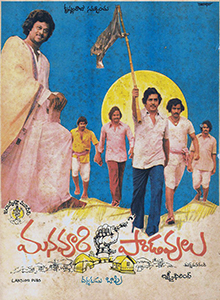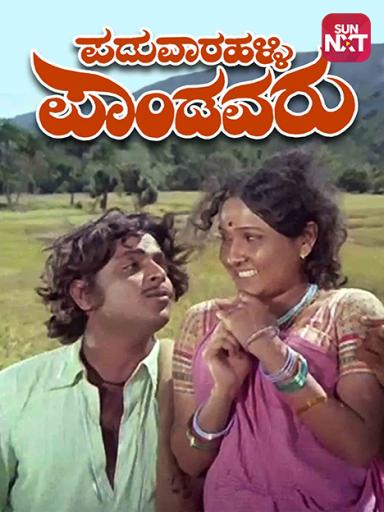
‘Manavoori Pandavlu is a remake of ‘Paduvaarali Pandavaru’, a Kannada movie by the veteran director, Puttanna Kanagal. The theme and plot of the movie is inspired by the epic Mahabharatha, featuring the revolt of oppressed villagers against the tyrannical village head. Both movies tasted success at the box-office.

‘Manavuri Pandavalu’ is an excellent example of how to build on existing material and further enhance it in terms of writing and direction. In this case the source being Mahabharatha, the master duo of Bapu-Ramana, adds a few more scenes from the epic, like the attempt to set fire to the wooden house, where Kunthi and Pandavas reside.
Here are a few key changes that add to the betterment of the movie.
- In the original, a swami/priest associated with a temple, who is insulted and manhandled in the beginning, becomes a hero later to bring about the change in villagers. In ‘Manavoori Pandavlu’, this character is split into two; the devoted temple priest (Ramana Murthy) and the swami as an intellectual and a drunkard. This is a master stroke in screenplay, that serves as a unique display of heroism and also plays on the popular metaphor of the divine hand waiting for the right time to strike. Krishnam Raju delivers a stand out performance and the Bapu-Ramana duo once again have to be credited for creating the characterization for him to shine. With Vemana book in one hand, local liquor bottle in another, Krishnam Raju’s character is one of the best in Telugu cinema. Krishna’s real avatar begins when the battle lines are drawn and he relinquishes the bottle as a signal to begin his true work. Just like in Mahabharatha’s Kurukshetra episode, this Krishna too doesn’t use arms, and his words being his ammunition. And who better to supply it, than the original ‘Maatala Mantrikudu’, Mullapudi Venkataramana. Each dialogue adds a new meaning and enhances the remake over the original.
- The overall tone of the Kannada movie is that of a street play, laced with loads of melodrama and over the top performances. ‘Manavoori Pandavulu’ mellows this down and Director Bapu brings about his classy poetic touch to the overall proceedings, with the ace cinematographer, Balu Mahendra by his side, he paints every frame in his unique style. Let it be drama or sentiment, he understates it with his brilliant compositions. The best examples being the scene where Krishnam Raju is introduced and in which Bheema (Prasad Babu) changes from being servile to hostile.( It is interesting to see how the masters (Bapu-Ramana) further make changes to the same scene in their Hindi version–‘Hum Paanch’–where Bheema (Mithun Chakravarthy) rises against Vir Pratap Singh (Amrish Puri), with the rays of sun light behind.)
- ‘Manavoori Pandavulu’, true to its rural milieu, sports a lovely folk songs based music track and an equally effective background score by the inimitable K.V.Mahadevan. Every song is a gem with terrific lyrics and every scene is underscored by his brilliance.
- The climax involving the realisation of the villain in ‘Manavuri Pandavlu,’ is a good change in view of the nativity of Telugu audience, and the relationship between the hero and the villain. Further gives the movie a happy ending instead of creating a leftist aftertaste.
All these and many more, makes ‘Mana voori Pandavulu’ stand out on its own. Bapu-Ramana, being the masters they are, imbibe the craft of giving the remakes a unique touch, with charecterization, screenplay, music etc, both from Hollywood ( ‘The magnificent seven’ and Akira Kurasowa’s Seven Samarai) and our own Telugu classics like Lavakusa.
The best part of the movie is that it can be remade with any new cast with a known face for the hero and a brand new backdrop and still enjoy spectacular results as the source is the timeless epic of Mahabharatha.
Tailpiece: Krishnam Raju is often quoted saying a remake of this classic is in the offing with Prabhas. It would be interesting to see how it unfolds.


